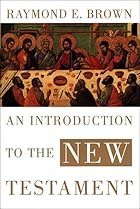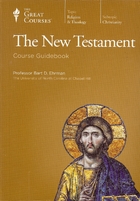

I've finished reading chapter 1 of An Introduction to the New Testament, by Raymond E Brown for the great course The New Testament (The Great Courses, Course Number 656), by Bart D. Ehrman.
Notes on Chapter 1:
The meaning of the word "Testament" has developed over time. At first, it was in reference to deals God had made with Noah, Abraham, David, and Moses - most notably the one to Moses in which the people of Israel were made "God's chosen people." Almost 600 years before the birth of Jesus, the prophet Jeremiah predicted "The days are coming when I will make a new covenant..." (Jer 31:31), where a covenant is a testament, and new means renewed. Then, before Jesus died, he referenced a new covenant/testament in his blood. Through his death and resurrection, therefore, Christians believed that god had renewed his covenant with his people, this time including the Gentiles. Only in the 2nd century do we see the word "testament" referring to a body of literature.
And, in fact, the idea of recording Jesus' story and sayings did not occur until after Jesus' death. Jesus didn't produce any written lectures, nor did he, in any of the Christian writings, suggest that his word be recorded. Letters were the first form of literature on Christian beliefs, and they were meant to answer immediate, pressing problems in the community to which they were addressed. Therefore, the letters of Paul have a different tone and emphasis in each, sometimes to the point of seeming contradictory.
By the late 60s, anybody who had had direct contact with Jesus had died. The passing of the first generation of Christians led to writings of a more permanent nature. These include the deuteroPauline writings such as II Thes, Col, Eph, I and II Tim, and Titus, which were written after Paul's death. The deuteroPauline letters have a more permanent and universal tone than earlier letters.
The Gospels also had a more permanent tone than early Pauline letters, but relevance to Christian problems would still have influenced which works were preserved. Mark's gospel emphasized the suffering of Christ on the cross, which would relate easily to the sufferings of early Christian persecution. The gospels of Matthew and Luke, probably written about 20 years later, are much more focused on the Jesus tradition, including sayings of Jesus which are hypothesized to originated in an earlier document dubbed "Q."
The Acts of the Apostles was probably meant as a continuation of Luke's gospel. It moved the story of Christianity beyond Jerusalem and Judea to Samaria and beyond.
The Book of Revelation is an example of apocalyptic literature with roots in Ezekiel and Zechariah. Apocalyptic literature was quite common at the time. Unfortunately, many modern readers have forgotten that the book was written to 1st century Christians, who would be quite familiar with the symbolic meaning of apocalyptic literature; they therefore interpret the Book of Revelation literally.
There are three reasons early Christian writings were preserved: 1) Apostolic origin - books that were purported to be written by apostles of Jesus (or Paul) had special place among Christians. 2) Which Christian communities the literature was addressed to - for instance, very little literature survives from Jerusalem or Judea, which was torn apart by the Jewish Revolt in 66-70. 3) Conformity with the rule of faith.
There is also a question of why we need 4 gospels instead of just 1. (This was discussed in my notes on Gamble's book.) Brown suggests that concentration on one gospel could be used to support theology rejected by a large number of Christians. An example of this problem is the beliefs of the Marcionites (also mentioned in detail in my notes on Gamble). The Marcionites believed that the creator God is not the same as the all-loving God of the NT. Therefore, the OT and teachings of Judaism should be rejected. Brown suggests that one reason the Church embraced four gospels was to refute Marcion's belief that only the gospel of Luke and the letters of Paul should be considered as canon. Brown also suggests that the Church embraced the OT to refute Marcion's rejection of it. However, in his book Gamble cautioned against putting too much emphasis on ONE driving factor for the Church's choices, and I agree with him on that.
No comments:
Post a Comment
What do you think? I love getting comments!